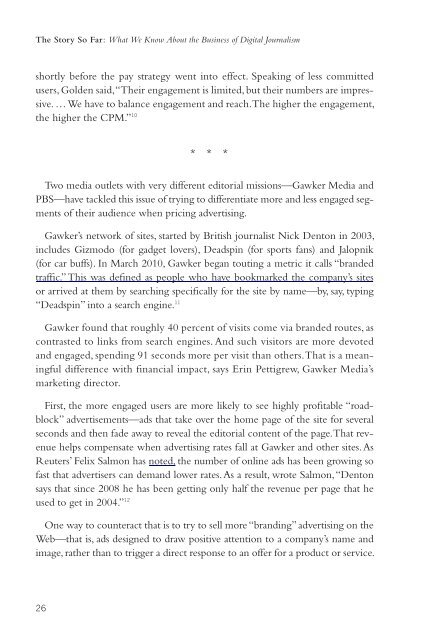Columbia <strong>Journalism</strong> School | Tow Center for <strong>Digital</strong> <strong>Journalism</strong>Fans, despite <strong>the</strong>ir small numbers, were responsible for more than 55 percent <strong>of</strong><strong>the</strong> site’s traffic. Fly-bys—those people most likely to come from a search engineor a blog—clicked on barely three pages a month. Overall, each fan generatedabout 50 times more traffic per person than a fly-by.“When people talk about <strong>the</strong> size <strong>of</strong> an audience, that’s a sham,” Shanahan says.In his view, stated numbers don’t reflect how differently <strong>the</strong> varieties <strong>of</strong> users actin <strong>the</strong> way <strong>the</strong>y navigate a site. Publishers mistakenly focus on “page views ra<strong>the</strong>rthan length <strong>of</strong> time,” he writes on his blog, <strong>Digital</strong> Equilibrium. 8 Referring to ad“impressions,” which are appearances (not clicks) <strong>of</strong> ads, Shanahan adds, “Usingtoday’s standard, <strong>the</strong>re is no difference between impressions that last 1 second, 10seconds, or 2 minutes.”“The digital world has changed <strong>the</strong> revenue dynamics for publishers,” he addsin ano<strong>the</strong>r post. “In <strong>the</strong> print world, a publisher’s shipment <strong>of</strong> physical media was<strong>the</strong> basis for generating revenue. In <strong>the</strong> digital world, consumption <strong>of</strong> media is<strong>the</strong> basis for revenue. ... In o<strong>the</strong>r words, engagement is <strong>the</strong> unit <strong>of</strong> monetization.” 9Shanahan says <strong>the</strong> benefit <strong>of</strong> more engagement isn’t just in higher ad rates,but in relationships that publishers need to build with <strong>the</strong>ir most loyal readers—something that has been lost in <strong>the</strong> drive to attract mass audiences. By chasingafter large audiences ra<strong>the</strong>r than deeply engaged ones, he says, news organizationsare sacrificing advertising revenue. Publishers who have a “direct relationshipwith fans can push better contextual advertising”—that is, ads that relate directlyto a user’s habits and interests. “A publisher can know which fans saw whichadvertisements in which context on <strong>the</strong>ir site.” Sites can use that information toprovide readers with targeted ads or <strong>of</strong>fers.And, news organizations that hope to charge for online access need to locate—andcater to—fans, since engaged users are more likely to subscribe. Thatway <strong>of</strong> thinking is at <strong>the</strong> heart <strong>of</strong> <strong>the</strong> New York Times’ decision to charge foraccess to its digital editions. The Times built its pay scheme so light users <strong>of</strong> <strong>the</strong>site won’t have to pay for access, while heavier users—defined as those clickingon at least 20 stories a month—will be charged. But <strong>the</strong> Times also sees aconnection between engagement and advertising. Michael Golden, vice chairmanand president <strong>of</strong> <strong>the</strong> New York Times Co., discussed <strong>the</strong> different kinds<strong>of</strong> online audiences during a speech at a March 2011 advertising conference,The Trouble with Traffic: Why Big Audiences Aren’t Always Pr<strong>of</strong>itable 25
The Story So Far: <strong>What</strong> <strong>We</strong> <strong>Know</strong> <strong>About</strong> <strong>the</strong> <strong>Business</strong> <strong>of</strong> <strong>Digital</strong> <strong>Journalism</strong>shortly before <strong>the</strong> pay strategy went into effect. Speaking <strong>of</strong> less committedusers, Golden said, “Their engagement is limited, but <strong>the</strong>ir numbers are impressive.… <strong>We</strong> have to balance engagement and reach. The higher <strong>the</strong> engagement,<strong>the</strong> higher <strong>the</strong> CPM.” 10 * * *Two media outlets with very different editorial missions—Gawker Media andPBS—have tackled this issue <strong>of</strong> trying to differentiate more and less engaged segments<strong>of</strong> <strong>the</strong>ir audience when pricing advertising.Gawker’s network <strong>of</strong> sites, started by British journalist Nick Denton in 2003,includes Gizmodo (for gadget lovers), Deadspin (for sports fans) and Jalopnik(for car buffs). In March 2010, Gawker began touting a metric it calls “brandedtraffic.” This was defined as people who have bookmarked <strong>the</strong> company’s sitesor arrived at <strong>the</strong>m by searching specifically for <strong>the</strong> site by name—by, say, typing“Deadspin” into a search engine. 11Gawker found that roughly 40 percent <strong>of</strong> visits come via branded routes, ascontrasted to links from search engines. And such visitors are more devotedand engaged, spending 91 seconds more per visit than o<strong>the</strong>rs. That is a meaningfuldifference with financial impact, says Erin Pettigrew, Gawker Media’smarketing director.First, <strong>the</strong> more engaged users are more likely to see highly pr<strong>of</strong>itable “roadblock”advertisements—ads that take over <strong>the</strong> home page <strong>of</strong> <strong>the</strong> site for severalseconds and <strong>the</strong>n fade away to reveal <strong>the</strong> editorial content <strong>of</strong> <strong>the</strong> page. That revenuehelps compensate when advertising rates fall at Gawker and o<strong>the</strong>r sites. AsReuters’ Felix Salmon has noted, <strong>the</strong> number <strong>of</strong> online ads has been growing s<strong>of</strong>ast that advertisers can demand lower rates. As a result, wrote Salmon, “Dentonsays that since 2008 he has been getting only half <strong>the</strong> revenue per page that heused to get in 2004.” 12One way to counteract that is to try to sell more “branding” advertising on <strong>the</strong><strong>We</strong>b—that is, ads designed to draw positive attention to a company’s name andimage, ra<strong>the</strong>r than to trigger a direct response to an <strong>of</strong>fer for a product or service.26
















